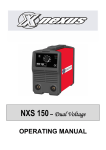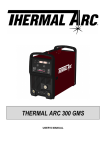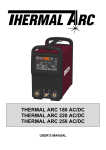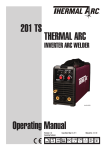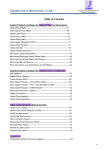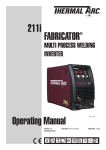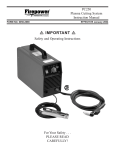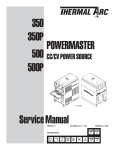Download THERMAL ARC 155 SE - Victor Technologies
Transcript
THERMAL ARC 155 SE USER’S MANUAL The machine you have just acquired has taken advantages, in its production, of Thermal Arcs' wide experience in the manufacturing of welding machines, along with the latest technology strides in power electronics. It will give you entire satisfaction for years if you respect all the operating and maintenance instructions given in this manual. We strongly suggest you read very carefully chapters concerning safety and individual protection before using this machine. We thank you in advance for your co-operation. THERMADYNE INDUSTRIES reserve the right to make changes without previous notification. Illustrations, descriptions and characteristics are not contractually binding and do not engage the responsability of the manufacturer. USER’S MANUAL Page 2/22 THERMAL ARC 155 SE Notice NOT 020 Rev : 02 Date : 25/10/06 TABLE OF CONTENTS WARRANTY POLICY STATEMENT ........................................................................................... 5 SAFETY....................................................................................................................................... 6 1. ELECTROMAGNETIC COMPATIBILITY ................................................................................................................6 1.1. DECLARATION OF CONFORMITY ......................................................................................................................6 1.2. INSTALLATION AND USE.....................................................................................................................................6 1.2.1. ASSESSMENT OF AREA ...................................................................................................................................................7 1.2.2. METHODS OF REDUCING EMISSIONS..........................................................................................................................7 1.2.2.1. Public supply system.........................................................................................................................................................7 1.2.2.2. Maintenance of the arc welding equipment.......................................................................................................................8 1.2.2.3. Welding cables..................................................................................................................................................................8 1.2.2.4. Equipotential bonding .......................................................................................................................................................8 1.2.2.5. Earthing of the workpiece .................................................................................................................................................8 1.2.2.6. Screening and shielding ....................................................................................................................................................8 2. 3. ELECTRIC SAFETY.......................................................................................................................................................8 2.1. CONNECTION OF THE WELDING POWER SOURCE TO THE NETWORK ....................................................8 2.2. WORKING AREA.....................................................................................................................................................9 2.3. INTERVENING.........................................................................................................................................................9 2.4. MAINTENANCE.......................................................................................................................................................9 2.5. RISKS OF FIRE AND EXPLOSION ........................................................................................................................9 INDIVIDUAL PROTECTION......................................................................................................................................10 3.1. RISK OF EXTERNAL INJURIES...........................................................................................................................10 3.1.1. 3.1.2. THE WHOLE BODY .........................................................................................................................................................10 FACE AND EYES..............................................................................................................................................................10 3.2. RISK OF INTERNAL INJURIES............................................................................................................................11 3.3. SAFETY IN THE USE OF GASES (welding with TIG or MIG inert gases).........................................................11 3.3.1. 3.3.2. 3.3.3. COMPRESSED GAS CYLINDERS ..................................................................................................................................11 PRESSURE RELIEF VALVE............................................................................................................................................11 DETAILS ABOUT GASES................................................................................................................................................12 DESCRIPTION .......................................................................................................................... 13 4. GENERAL CHARACTERISTICS...............................................................................................................................13 5. TECHNICAL CHARACTERISTICS ..........................................................................................................................13 USER’S MANUAL Page 3/22 THERMAL ARC 155 SE Notice NOT 020 Rev : 02 Date : 25/10/06 TABLE OF CONTENTS SETTING UP ............................................................................................................................. 15 6. CONNECTION TO THE MAIN SUPPLY...................................................................................................................15 7. CONNECTION TO THE GROUND ............................................................................................................................15 8. PRELIMINARY PRECAUTIONS ...............................................................................................................................15 USING........................................................................................................................................ 16 9. DESCRIPTION OF THE FRONT PANEL..................................................................................................................16 10. DESCRIPTION OF THE BACK PANEL ................................................................................................................16 11. WELDING ..................................................................................................................................................................17 MAINTENANCE ........................................................................................................................ 18 12. MAINTENANCE .......................................................................................................................................................18 13. SPARE PARTS ...........................................................................................................................................................19 14. MAIN PCB REF L93211..........................................................................................................................................20 15. TROUBLE SHOOTING ............................................................................................................................................20 16. WIRING DIAGRAM .................................................................................................................................................21 USER’S MANUAL Page 4/22 THERMAL ARC 155 SE Notice NOT 020 Rev : 02 Date : 25/10/06 WARRANTY POLICY STATEMENT The Thermal Arc 155 SE is guaranteed 24 months from date of invoice.. Defects caused by natural wear or accidental damage (wrong assembly, defective maintenance, abnormal use ...) or by modification of the product, which has not been accepted in writing by the manufacturer, are not included in the guarantee. Guarantee covers free of charge replacement of parts, which have been admittedly defective (transport included). Every part replaced under guarantee will be automatically invoiced after a period of 1 month in case of non-return of the defective part. Labour executed by the distributor is entirely at their cost. However, if you request, labour can be performed free of charge by Thermadyne Industries, in its factory. In this case, transport to and from Thermadyne Industries will be at the distributor’s costs. USER’S MANUAL Page 5/22 THERMALARC 155 SE Notice NOT 020 Rev : 02 Date : 25/10/06 SAFETY The equipment you have just acquired will give you entire satisfaction if you respect the operating and maintenance instructions. Its design, the specification of the components and its manufacture are in accordance with the existing rules, French standards (NF), ISO and CEI international injunctions, EEC general lines and CEN/CENELEC standards. In this chapter, you will find safety rules in the use of electric arc welding power sources with coated electrodes. We give you hereunder a list of recommandations and obligations you have to respect. Safety rules must be observed, and particulary those relating to Decree 88.1056 dated November 14., 1988 concerning protective measures against electric currents. 1. ELECTROMAGNETIC COMPATIBILITY 1.1. DECLARATION OF CONFORMITY THERMADYNE Industries hereby declare that the machine object of this manual complies with the following European regulations : Electromagnetic compatibility : Rule 89/336-EEC of 3/05/89 modified by rules 92/31-EEC of 28/04/1992 and 93/68-EEC of 22/07/1993. Low voltage : Rule 73/23-EEC of 19/02/1973 modified by rule 93/68-EEC of 22/07/1993. and with the national legislation transposing them. THERMADYNE Industries also declare that following harmonised standards have been applied : EN 60974-10 (2003): Electromagnetic compatibility (CEM) – Product norm for arc welding material. EN 50060 (1990): Current source for arc manual welding with limited service. EN 60974-1: Security rules for electric welding material. Part 1: welding current sources. EN 50192 (1995): Arc welding material – plasma cutting systems. 1.2. INSTALLATION AND USE The machine object of this manual complies with the European regulations about electromagnetic compatibility 89/336 CEE. It also complies with EN 50199 standard: Electromagnetic compatibility, product standard for welding machines. The user is responsible for installing and using the arc welding equipment according to the manufacturer’s instructions. USER’S MANUAL Page 6/22 THERMAL ARC 155 SE Notice NOT 020 Rev : 02 Date : 25/10/06 SAFETY If electromagnetic disturbances are detected, then it shall be the responsibility of the user of the arc welding equipment to resolve the situation with the technical assistance of the manufacturer. In some cases this remedial action may be as simple as earthing the welding circuit, see Note. In other cases it could involve constructing an electromagnetic screen enclosing the welding power source and the work complete with associated input filters. In all cases electromagnetic disturbances shall be reduced to the point, where they are no longer troublesome. NOTE - The welding circuit may or may not be earthed for safety reasons. Changing the earthing arrangements should only be authorised by a person who is competent to assess whether the changes will increase the risk of injury, e.g. by allowing parallel welding current return paths, which may damage the earth circuits of other equipment. Further guidance is given in IEC 62081 "Arc welding equipment - Installation and use" (under consideration). 1.2.1. ASSESSMENT OF AREA Before installing arc welding equipment the user shall make an assessment of potential electromagnetic problems in the surrounding area. The following shall be taken into account : a) Other supply cables, control cables, signalling and telephone cables, above, below and adjacent to the arc welding equipment; b) Radio and television transmitters and receivers; c) Computer and other control equipment; d) Safety critical equipment, e.g. guarding of industrial equipment, e) The health of the people around, e.g. the use of pacemakers and hearing aids; f) Equipment used for calibration or measurement; g) The immunity of other equipment in the environment. The user shall ensure that other equipment being used in the environment is compatible. This may require additional protection measures; h) The time of day that welding or other activities are to be carried out. The size of the surrounding area to be considered will depend on the structure of the building and other activities that are taking place. The surrounding area may extend beyond the boundaries of the premises. 1.2.2. METHODS OF REDUCING EMISSIONS 1.2.2.1. Public supply system Arc welding equipment should be connected to the public supply system according to the manufacturer’s recommendations. If interference occurs, it may be necessary to take additional precautions such as filtering of the public supply system. Consideration should be given to shielding the supply cable of permanently installed arc welding equipment, in metallic conduit or equivalent. Shielding should be electrically continuous throughout its length. The shielding should be connected to the welding power source so that good electrical contact is maintained between the conduit and the welding power source enclosure. USER’S MANUAL Page 7/22 THERMAL ARC 155 SE Notice NOT 020 Rev : 02 Date : 25/10/06 SAFETY 1.2.2.2. Maintenance of the arc welding equipment The arc welding equipment should be routinely maintained according to the manufacturers recommendations. All access and service doors and covers should be closed and properly fastened when the arc welding equipment is in operation. The arc welding equipment should not be modified in any way, except for those changes and adjustments covered in the manufacturer’s instructions. In particular, the spark gaps of arc striking and stabilising devices should be adjusted and maintained according to the manufacturer’s recommendations. 1.2.2.3. Welding cables The welding cables should be kept as short as possible and should be positioned close together, running at or close to the floor level. 1.2.2.4. Equipotential bonding Bonding of all metallic components in the welding installation and adjacent to it should be considered. However, metallic components bonded to the work piece will increase the risk that the operator could receive an electric shock by touching these metallic components and the electrode at the same time. The operator should be insulated from all such bonded metallic components. 1.2.2.5. Earthing of the workpiece Where the workpiece is not bonded to earth for electrical safety, nor connected to earth because of its size and position, e.g. ships hull or building steelwork, a connection bonding the workpiece to earth may reduce emissions in some, but not all instances. Care should be taken to prevent the earthing of the workpiece increasing the risk of injury to users, or damage to other electrical equipment. Where necessary, the connection of the workpiece to earth should be made by a direct connection to the workpiece, but in some countries where direct connection is not permitted, the bonding should be achieved by suitable capacitance, selected according to national regulations. 1.2.2.6. Screening and shielding Selective screening and shielding of other cables and equipment in the surrounding area may alleviate problems of interference. Screening of the entire welding installation may be considered for special applications. 2. ELECTRIC SAFETY 2.1. CONNECTION OF THE WELDING POWER SOURCE TO THE NETWORK Before connecting your equipment, you must check that: -The meter, the safety device against over-currents, and the electric installation are compatible with the maximum power and the supply voltage of the welding power source (refer to the instructions plates). -The connection, either single-phase, or three-phase with earth can be effected on a socket compatible with the welding power source cable plug. If the cable is connected to a fixed post, the earth, if provided, will never be cut by the safety device against electric shocks. -The ON/OFF switch (if exists) situated on the welding power source, is turned off. USER’S MANUAL Page 8/22 THERMAL ARC 155 SE Notice NOT 020 Rev : 02 Date : 25/10/06 SAFETY 2.2. WORKING AREA The use of arc welding implies a strict respect of safety conditions with regard to electric currents (Decree dated 14.12.1988). It is necessary to check that no metal piece accessible to the operators and to their assistants can come into direct contact with a phase conductor and the neutral of the network. In case of uncertainty, this metal part will be connected to the earth with a conductor of at least equivalent section to the largest phase conductor. Make sure that all metal pieces that the operator could touch with a non insulated part of his body (head, hands without gloves on, naked arms ...) is properly grounded with a conductor of at least equivalent section to the biggest supply cable of the ground clamp or welding torch. If more than one metal ground are concerned, they need to be all interlinked in one, which must be grounded in the same conditions. Unless very special care have been taken, do not proceed to any arc welding or cutting in conductive enclosures, whether it is a confined space or the welding machine has to be left outside. Be even more prudent when welding in humid or non ventilated areas, and if the power source is placed inside (Decree dated 14.12.1988, Art. 4). 2.3. INTERVENING -Before carrying out any internal checking or repair work, check that the power source has been separated from the electrical installation by locking and guard devices. -The current plug has to be taken out. Provisions have to be taken to prevent an accidental connection of the plug to a socket. -Cut-off through a fixed connecting device has to be omnipolar (phases and neutral). It is in the "OFF" position and cannot be accidentally put into operation. -Maintenance works of electrical equipment must be entrusted to qualified people (Section VI, Art. 46). 2.4. MAINTENANCE Check the good state, insulation and connection of all the equipment and electrical accessories: plugs and flexible supply cables, cables (NF A 32-510), conduits, connectors, extension cables (NF A 85-610 and CENELEC HD 433), sockets on the power source, ground and electrode-holder clamps (NF A 85-600). These connections and mobile accessories are marked according to standards, if consistent with the safety rules. They can either be controlled by you or by accredited firms. - Maintenance and repair works of conduits and liners have to be properly carried out (Section VI, Art. 47). -Repair or replace all defective accessories -Check periodically that the electrical connections are tightened and do not heat. 2.5. RISKS OF FIRE AND EXPLOSION Welding can occur risks of fire or explosion. You have to pay attention to fire safety regulation - Remove flammable or explosive materials from welding area. USER’S MANUAL Page 9/22 THERMAL ARC 155 SE Notice NOT 020 Rev : 02 Date : 25/10/06 SAFETY - Always have sufficient fire fighting equipment - Fire can break out from sparks even several hours after the welding work has been finished. 3. INDIVIDUAL PROTECTION 3.1. RISK OF EXTERNAL INJURIES 3.1.1. THE WHOLE BODY Arc rays produce very bright ultra violet and infra red light. They will damage yours eyes and burn your skin if you are not properly protected -The welder is dressed and protected according to the constraints his works impose him. -Insulate yourself from the workpiece and the ground. Make sure that no metal piece, especially those connected to the network, can come into contact with the operator. -The welder must always wear an individual insulating protection (decree of 14/12/1988, article 3-3). Protective clothing : gloves, aprons, safety shoes offer the additional advantage to protect the operator against burns caused by hot pieces and spatter. This protective equipment should be kept in good order and checked on a regular basis. 3.1.2. FACE AND EYES -.It is absolutely necessary to protect your eyes against arc rays. - Protect your hair and your face against sparks The welding shield, with or without headset, is always equipped with a proper filter according to the arc welding current (NS S 77-104 / A 88-221 / A 88.222 standards). In order to protect shaded filter from impacts and sparks, you have to add a plain glass in front of the shield. The helmet provided with your equipment (if requested) is equipped with a protective filter. When you want to replace it, precise the reference and number of opacity degree of the filter. Use the shade of lens as recommended in the instruction manual (opacity graduation number) Protect others in the work area from arc rays by using protective booths, UV protective goggles, and if necessary, a welding shield with appropriate protective filter on (NF S 77-104 - by A 1.5). USER’S MANUAL Page 10/22 THERMAL ARC 155 SE Notice NOT 020 Rev : 02 Date : 25/10/06 SAFETY Opacity gradation numbers and recommended use for arc welding Current intensity in Amps Welding process or connected techniques 0.5 2.5 1 10 5 20 15 40 30 80 60 125 100 175 225 275 350 450 150 200 250 300 400 500 Coated electrodes 9 10 11 12 MIG on heavy metals 10 11 12 MIG on light alloys 10 11 12 13 TIG on all metals 9 10 11 12 13 14 MAG 10 11 12 13 Air/Arc gouging 10 11 12 13 Plasma cutting 9 10 11 12 13 Depending on the conditions of use, the next highest or lowest category number may be used. The expression “heavy metals” covers steels, alloyed steels, copper and its alloys. The shaded areas represent applications where the welding processes are not normally used at present. CARE : 13 13 14 14 14 14 14 15 15 15 Use a higher degree of filters if welding is performed in premises which are not well lighted. 3.2. RISK OF INTERNAL INJURIES GASES AND FUMES Gases fumes produced during the welding process can be dangerous and hazardous to your health. Arc welding works have to be carried out in suitable ventilated areas. Ventilation must be adequate to remove gases and fumes during operation. All fumes produced during welding have to be removed as soon as they are given off, and as close as possible from the place they are produced to be the most efficient. Vapors of chlorinated solvents can form the toxic gas phosgene when exposed to ultraviolet radiation from an electric arc. 3.3. SAFETY IN THE USE OF GASES (WELDING WITH TIG OR MIG INERT GASES) 3.3.1. COMPRESSED GAS CYLINDERS Compressed gas cylinders are potentially dangerous. Refer to suppliers for proper handling procedures. - No impact: secure the cylinders and keep them away from impacts. - No excess heat (over 50°C) 3.3.2. PRESSURE RELIEF VALVE Check that the pressure relief screw is slackened off before connecting to the cylinder. Check that the union is tight before opening the valve of the cylinder. Open it slowly a fraction of a turn. If there is a leak, NEVER tighten a union which is under pressure, but first close the valve on the cylinder. Always check that hoses are in good condition. USER’S MANUAL Page 11/22 THERMAL ARC 155 SE Notice NOT 020 Rev : 02 Date : 25/10/06 SAFETY 3.3.3. DETAILS ABOUT GASES Gas and gaseous mixtures containing less than 20% of CO2: If these gases or mixtures take the place of the oxygen in the air, there is a danger of asphyxia. An atmosphere containing less than 17% oxygen is dangerous. hydrogen and hydrogen-based combustible gaseous mixtures These are very light gases. In the case of leaks, they collect under the ceiling. Provide for ventilation at ceiling level. These are also inflammable gases. The flame of hydrogen is almost invisible. There is therefore a risk of burns. Air/hydrogen and oxygen/hydrogen mixtures are explosive in the following proportions: - 4 to 74.5 % of hydrogen in air. - 4 to 94 % of hydrogen in oxygen. Store the bottles in the open or in a well-ventilated place. Avoid any leakage by limiting the number of connections or couplings to a minimum. USER’S MANUAL Page 12/22 THERMAL ARC 155 SE Notice NOT 020 Rev : 02 Date : 25/10/06 DESCRIPTION 4. GENERAL CHARACTERISTICS THERMAL ARC 155 SE welding machines have been designed as integrated and portable units using the latest techniques in power electronics, based on an inverter process with IGBT, which enables the following: - a considerable reduction of weight and volume, the dynamic control of the welding current, the specific protection of power components, a high power in a small space at a very low power consumption. THERMAL ARC 155 SE unit allows 2 possibilities of power supply : ever 110V or 230 V. It automatically senses the input voltage value (smart link TM) without needing any switching by the operator. It has built-in over voltage protection when its power supply is 110 V which allows engine driven generator supply. It allows stick welding with coated electrodes and TIG process with a valve torch. 5. TECHNICAL CHARACTERISTICS DIMENSIONS ( in mm ) USER’S MANUAL Page 13/22 Notice NOT 020 THERMAL ARC 155 SE Rev : 02 Date : 25/10/06 DESCRIPTION For ambient temperature : 40°C THERMAL ARC 155 SE 110 V 230 V 110 V (+/- 13%) 230 V (+/- 13%) PRIMARY Single phased power supply V Frequency Hz Maximum primary current A 32 23 kVA 3,7 5,3 Maximum power consumption 50/60 Power factor (cos Ø) 0,98 SECONDARY Off load voltage V 50-60 Welding current range A 3-120 3-150 Welding current at 35 % A - 150 Welding current at 60 % A - 130 Welding current at 100 % A 110 110 Protection factor IP 23 Insulation class H Approvals Weight Dimensions L x W x H EN 60974-1 / EN 60974-10 kg 6,2 mm 327 x 152 x 243 NOTE : When the machine is supplied in 110V, the welding current is limited to 120A USER’S MANUAL Page 14/22 THERMAL ARC 155 SE Notice NOT 020 Rev : 02 Date : 25/10/06 SETTING UP 6. CONNECTION TO THE MAIN SUPPLY The power source must be connected to a single-phase 230V or 110V - 50 Hz/60 Hz mains + ground with a tolerance of +/- 13%. It has built-in over voltage protection (if the power supply is 110V) which allows engine driven generator supply Main supply must be protected by fuses or circuit-breaker according to the value I1eff written on the specifications of the power source. It is strongly suggested to use a differential protection for the operator’s safety. 7. CONNECTION TO THE GROUND For the operator's protection, the power source must be correctly grounded (according to the International Protections Norms). It is absolutely necessary to set a good ground connection installation with the green/yellow leading of the power cable. This will avoid discharges caused by accidental contacts with grounded pieces. If no earth connection has been set, a high risk of electric shock through the chassis of the unit remains possible. 8. PRELIMINARY PRECAUTIONS For the good operation of your welding power source, make sure that the air flow produced by the fan inside the unit is not obstructed. Also try to operate in a non-dusty area. Avoid all impacts, exposure to damp areas or excessive temperatures. USER’S MANUAL Page 15/22 THERMAL ARC 155 SE Notice NOT 020 Rev : 02 Date : 25/10/06 USING 9. DESCRIPTION OF THE FRONT PANEL REPERE F1 F2 F3 F4 F5 DESIGNATION Welding current knob Power terminal + Warning indicator Power ON indicator Power terminal - 10. DESCRIPTION OF THE BACK PANEL REPERE DESIGNATION B1 Input cable B2 ON/OFF main switch USER’S MANUAL Page 16/22 THERMAL ARC 155 SE Notice NOT 020 Rev : 02 Date : 25/10/06 USING 11. WELDING Connect the power source to the main supply and the ground as explained in the chapter « Setting up » ( as para 6 and 7). The THERMAL ARC 155 SE unit automaticaly recogonizes the value of the power supply. Connect the ground cable and the electrode-holder to the appropriate power connections + (F2) and - (F5) according to the electrode polarity being used (refer to the electrodes manufacturer’s datasheets). Start up the power source with the switch ON/OFF (B2). When you start the power source, the orange indicator (F3) illuminates but goes out immediatly if no failure has been found. The green indicator (F4) illuminates and indicates that the machine is live. Adjust welding current with potentiometer (F1) Place the electrode on the piece you have to weld in order to strike the arc. Arc force control Adjustment of arc force control is not possible, but it is optimised for welding with a large range of rutile and basic electrodes. USER’S MANUAL Page 17/22 THERMAL ARC 155 SE Notice NOT 020 Rev : 02 Date : 25/10/06 MAINTENANCE 12. MAINTENANCE CAUTION : BEFORE OPENING the unit, disconnect the power source from the mains. Voltages are high and dangerous inside the machine. In spite of their robustness, THERMAL ARC power sources require some regular maintenance. Once every 6 months (more often in dusty surroundings) : - the machine must be blown through with dry, oilfree compressed air check for continuity all electrical connections. Check all cable connections, including ribbon cables. USER’S MANUAL Page 18/22 THERMAL ARC 155 SE Notice NOT 020 Rev : 02 Date : 25/10/06 MAINTENANCE 13. SPARE PARTS ITEM 1 2 3 4 5 6 7 8 9 10 11 12 13 REFERENCE I05822 V01002 B05025 I05801 I05812 E10207/TH T18107 I05831 B00011/TH B01062 010316 I05890 L93213 B04015 J05004 DESCRIPTION Black back frame Fan 12Vdc supply ON/OFF main switch Chassis Black front frame Main PCB Complete inductor Cover Front fascia Knob diam. 23 Strap Cable anchorage Front panel PC board Thermostat 80°C PCB insulator 205*248 USER’S MANUAL Page 19/22 THERMAL ARC 155 SE Notice NOT 020 Rev : 02 Date : 25/10/06 MAINTENANCE 14. MAIN PCB REF L93211 Connector J1, J5 : 110V / 230V AC main supply, protected against over voltage on main supply Connector J2 : Protective earth connection Connector J3 : Connection for 12V dc fan (pin 1 + ; pin 2 -) Connector J4 : pin 1 & 2 : thermostat on diode Connector J6 : front panel flat cable connection pin 1 : maximum of front panel potentiometer pin 2 : cursor of front panel potentiometer pin 3 : electronic ground – minimum of front panel potentiometer Connector J7 : connector. Flat cable connection on front panel potentiometer corresponding to pin 1,2 and 3 of J6 15. TROUBLE SHOOTING POSSIBLE CAUSES CHECKING / REMEDY GREEN AND ORANGE INDICATORS OFF = NO SUPPLY ON/OFF main switch is OFF Put the switch ON Power supply cable is cut Check cable and connections No main supply Check circuit breaker and fuses Defective ON/OFF main switch Replace the switch GREEN AND ORANGE INDICATORS ON = WARMING UP Duty cycle over rated (particulary if ambient Let the machine cool, it will automatically start again t° is > 25°C) Insufficient cooling air Clean the air inlets Very dusty machine Open the machine and blow it through Fan doesn’t start Replace the fan IMPROPER WELDING Wrong electrode polarity Use the right polarity according to the indications of electrode’s manufacturer USER’S MANUAL Page 20/22 16. WIRING DIAGRAM Thermadyne Industries, Ltd. U.K Chorley, England Tel : (44) 01257 261 755 Fax : (44) 01257 224 802 Thermadyne Industries, Ltd. Netherlands Hoofddorp, Holland Tel : (31) 23 561 4182 Fax : (31) 23 565 5074 Thermadyne Industries, Ltd. Italia Milan, Italy Tel : (39) 039 204 991 Fax : (39) 039 204 9922 PTA Plasmatechnik. Germany Westerburg, Germany Tel : (49) 2663 915666 Fax : (49) 2663 915667 THERMADYNE INDUSTRIES reserve the right to make changes without previous notification. Illustrations, descriptions and characteristics are not contractually binding and do not engage the responsability of the manufacturer.






















